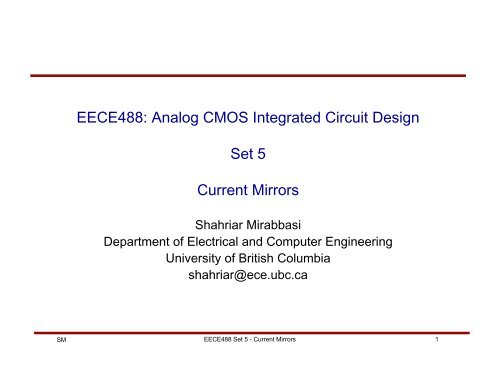EECE488: Analog CMOS Integrated Circuit Design Set 5 Current ...
EECE488: Analog CMOS Integrated Circuit Design Set 5 Current ...
EECE488: Analog CMOS Integrated Circuit Design Set 5 Current ...
Create successful ePaper yourself
Turn your PDF publications into a flip-book with our unique Google optimized e-Paper software.
SM<br />
<strong>EECE488</strong>: <strong>Analog</strong> <strong>CMOS</strong> <strong>Integrated</strong> <strong>Circuit</strong> <strong>Design</strong><br />
<strong>Set</strong> 5<br />
<strong>Current</strong> Mirrors<br />
Shahriar Mirabbasi<br />
Department of Electrical and Computer Engineering<br />
University of British Columbia<br />
shahriar@ece.ubc.ca<br />
<strong>EECE488</strong> <strong>Set</strong> 5 - <strong>Current</strong> Mirrors 1
SM<br />
Applications of <strong>Current</strong> Sources<br />
<strong>EECE488</strong> <strong>Set</strong> 5 - <strong>Current</strong> Mirrors 2
SM<br />
Simple Resistive Biasing for <strong>Current</strong> Source<br />
nCox<br />
W R<br />
IOUT ≈ ( −<br />
2 L R +<br />
µ<br />
2<br />
2 2<br />
VDD<br />
VTH<br />
)<br />
R1<br />
<strong>EECE488</strong> <strong>Set</strong> 5 - <strong>Current</strong> Mirrors 3
• Output current depends on:<br />
SM<br />
– Supply<br />
– Process<br />
– Temperature<br />
Problems<br />
• What if the bias voltage is independent of supply voltage?<br />
• Is there a way of generating reliable currents?<br />
<strong>EECE488</strong> <strong>Set</strong> 5 - <strong>Current</strong> Mirrors 4
SM<br />
Basic Idea<br />
Typically we assume that one precisely defined current source is<br />
available and other current sources copy their current from this precise<br />
source.<br />
I out is a function of gate-source voltage<br />
<strong>EECE488</strong> <strong>Set</strong> 5 - <strong>Current</strong> Mirrors 5
SM<br />
Basic Idea<br />
This structure is called current mirror<br />
<strong>EECE488</strong> <strong>Set</strong> 5 - <strong>Current</strong> Mirrors 6
SM<br />
Question<br />
• What happens if the two transistors in the basic current mirror<br />
have different sizes?<br />
<strong>EECE488</strong> <strong>Set</strong> 5 - <strong>Current</strong> Mirrors 7
SM<br />
Example<br />
Assuming all the transistors are in saturation region, find I out:<br />
<strong>EECE488</strong> <strong>Set</strong> 5 - <strong>Current</strong> Mirrors 8
SM<br />
<strong>Current</strong> Mirrors: Amplifier Bias Example<br />
<strong>EECE488</strong> <strong>Set</strong> 5 - <strong>Current</strong> Mirrors 9
SM<br />
Board Notes<br />
<strong>EECE488</strong> <strong>Set</strong> 5 - <strong>Current</strong> Mirrors 10
SM<br />
<strong>Current</strong> Mirrors: Signal Amplification Example<br />
• Find the small signal voltage gain of the following circuit.<br />
<strong>EECE488</strong> <strong>Set</strong> 5 - <strong>Current</strong> Mirrors 11
SM<br />
Effect of Channel Length Modulation<br />
<strong>EECE488</strong> <strong>Set</strong> 5 - <strong>Current</strong> Mirrors 12
SM<br />
Cascode <strong>Current</strong> Mirror<br />
<strong>EECE488</strong> <strong>Set</strong> 5 - <strong>Current</strong> Mirrors 13
SM<br />
Board Notes<br />
<strong>EECE488</strong> <strong>Set</strong> 5 - <strong>Current</strong> Mirrors 14
SM<br />
Cascode <strong>Current</strong> Mirror<br />
<strong>EECE488</strong> <strong>Set</strong> 5 - <strong>Current</strong> Mirrors 15
SM<br />
Cascode <strong>Current</strong> Mirror<br />
<strong>EECE488</strong> <strong>Set</strong> 5 - <strong>Current</strong> Mirrors 16
SM<br />
Cascode <strong>Current</strong> Mirror<br />
<strong>EECE488</strong> <strong>Set</strong> 5 - <strong>Current</strong> Mirrors 17
SM<br />
Board Notes<br />
<strong>EECE488</strong> <strong>Set</strong> 5 - <strong>Current</strong> Mirrors 18
SM<br />
Cascode <strong>Current</strong> Mirror Biasing<br />
<strong>EECE488</strong> <strong>Set</strong> 5 - <strong>Current</strong> Mirrors 19
SM<br />
Cascode <strong>Current</strong> Mirror Biasing<br />
<strong>EECE488</strong> <strong>Set</strong> 5 - <strong>Current</strong> Mirrors 20
SM<br />
<strong>Current</strong> Mirror Biasing<br />
<strong>EECE488</strong> <strong>Set</strong> 5 - <strong>Current</strong> Mirrors 21
SM<br />
Basic <strong>Circuit</strong> to Generate Supply Independent <strong>Current</strong><br />
<strong>EECE488</strong> <strong>Set</strong> 5 - <strong>Current</strong> Mirrors 22
SM<br />
Supply Independent <strong>Current</strong><br />
<strong>EECE488</strong> <strong>Set</strong> 5 - <strong>Current</strong> Mirrors 23
SM<br />
Board Notes<br />
<strong>EECE488</strong> <strong>Set</strong> 5 - <strong>Current</strong> Mirrors 24
SM<br />
Supply Independent <strong>Current</strong><br />
<strong>EECE488</strong> <strong>Set</strong> 5 - <strong>Current</strong> Mirrors 25
SM<br />
Start-up Problem<br />
<strong>EECE488</strong> <strong>Set</strong> 5 - <strong>Current</strong> Mirrors 26
SM<br />
Start-up Problem<br />
V > V<br />
TH1<br />
+ VTH<br />
5 + VTH<br />
3 < VDD<br />
and VGS1<br />
+ VTH<br />
5 + VGS<br />
3<br />
<strong>EECE488</strong> <strong>Set</strong> 5 - <strong>Current</strong> Mirrors 27<br />
DD
SM<br />
Board Notes<br />
<strong>EECE488</strong> <strong>Set</strong> 5 - <strong>Current</strong> Mirrors 28
SM<br />
Active <strong>Current</strong> Mirrors<br />
<strong>EECE488</strong> <strong>Set</strong> 5 - <strong>Current</strong> Mirrors 29
SM<br />
Active <strong>Current</strong> Mirrors in Differential to Single-Ended<br />
Amplifiers<br />
<strong>EECE488</strong> <strong>Set</strong> 5 - <strong>Current</strong> Mirrors 30
SM<br />
Differential to Single-Ended Amplifiers<br />
<strong>EECE488</strong> <strong>Set</strong> 5 - <strong>Current</strong> Mirrors 31
SM<br />
Calculation of G m<br />
I D1 = I D3 = I D 4 = g m1,2V in / 2 I D2 = −g m1,2V in /2<br />
I out = I D2 − I D4 = −g m1,2V in ,⇒ G m = g m1, 2<br />
<strong>EECE488</strong> <strong>Set</strong> 5 - <strong>Current</strong> Mirrors 32
SM<br />
Small-Signal Gain<br />
A v ≈ g m 1,2 (r o2 || r o4 )<br />
<strong>EECE488</strong> <strong>Set</strong> 5 - <strong>Current</strong> Mirrors 33
SM<br />
Common Mode Characteristics<br />
A CM = ∆V out<br />
∆V in,CM<br />
<strong>EECE488</strong> <strong>Set</strong> 5 - <strong>Current</strong> Mirrors 34
SM<br />
A CM ≈<br />
Common Mode<br />
1<br />
− ||<br />
2gm3,4 ro3,4 2<br />
1<br />
+ RSS 2gm1,2 =<br />
−1<br />
1 + 2g m1,2 R SS<br />
g m1,2<br />
g m 3, 4<br />
<strong>EECE488</strong> <strong>Set</strong> 5 - <strong>Current</strong> Mirrors 35
SM<br />
Common Mode<br />
CMRR = A DM<br />
A CM<br />
= g m1, 2(r o1,2 || r o3,4) g m 3,4 (1 + 2g m1,2 R SS )<br />
g m1,2<br />
= g m 3,4 (r o1, 2 || r o3,4 )(1 + 2g m1, 2 R SS )<br />
<strong>EECE488</strong> <strong>Set</strong> 5 - <strong>Current</strong> Mirrors 36

















